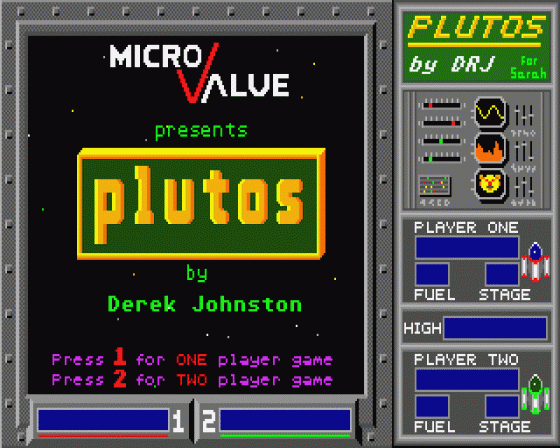Plutos
After Tynesoft's disappointing entry into the ST budget market with Time-blast and Liberator, I was more than a little wary of loading a game whose sleeve contained such modest statements as "the game you've all been waiting for" and "state of the art space action in its ultimate form".
Well, Starglider this isn't, but at £14.95 (a full £10 cheaper than Typhoon or Goldrunner) Plutos represents the best value per mangled alien on the ST.
As with Typhoon, the action takes place in a window, this time on the left-hand side of the screen, neatly framed in a metalic border. Unlike Typhoon, Plutos offers one or two player options. In the latter, both players compete, at the same time, to destroy the assorted goodies and nasties on or above a huge mothership that scrolls downwards, all too slowly, through numerous stages.

The nasties in Plutos don't so much come in waves, as in Typhoon, but in one continuous torrent affording little or no respite, except between stages, when you have a few seconds to work out where you can buy a replacement trigger finger if your original gives out!
Although almost anything in Plutos can be shot, some things are more important to get than others, fuel dumps being a perfect example. You start the game with a full tank (99 units) of fuel which is consumed at the rate of one unit per second. Each dump is worth 20 units. It is relatively easy to keep topping up your tank in the early stages, but later on there is an alarming decrease in fuel dumps on it's important to keep topping up while you can.
If you run out of fuel, you lose all control except that of the laser. You are thus condemned to sitting there and watching those nasty aliens destroying all those lives you've painstakingly built up. Your one salvation is if a fuel dump comes along, directly in your path, which you can shoot without having to move.

Apart from dumps, there are many other shootable items on the surface of the mothership, including circular turrets that fire back at you. Flying above the mothership are numerous beautifully animated alien craft that seem to have orders to carry out an almost relentless offensive against you.
At the end of each stage you must shoot out a pair of blinking eyes, thus gaining an extra life and access to the next - and even more frantic - part of the game. In stages one and four (and presumably later stages too difficult for this mortal to reach) you get yet more chances of gaining extra lives by shooting five "?" icons, each of which has a one-in-four chance of turning into a happy face (extra life awarded) icon.
As with Typhoon, later stages are pulled in from the disk. But this doesn't seem to be such a pain here as it happens at a natural break between stages. Incidentally, Plutos comes on just one disk!

To the right and below the action window are the status areas where you can keep a check on the stage you're in, the number of lives you've still got to play with, as well as your score and fuel status. In the two player game two sets of information are displayed.
If hit by any flying alien, raised structure on the mothership, or bullet from alien or gun turret, you lose a life. But programmer Derek Johnson, obviously a shoot-'em-up junkie on the quiet, has allowed play to continue during the transition between one life and the next.
Instead of an explosion followed by a break in the action, Plutos allows you to continue manoeuvring your ship (now just a red outline and impervious to damage) for a grace period of about three seconds. At the end of the grace period, the outline ship is once again filled with its normal colours. Your ship can once again sustain damage (ie. You can be killed) and the game continues as per normal - minus one life of course!
By thoughtful game design such as this, Plutos manages to overcome such shortfalls as poor sound effects and slow scrolling. Instead it whips you up into a destructive frenzy and doesn't let go. When you find yourself swearing at an inanimate object (namely a monitor) and fighting a losing battle against finger cramp, you know the game's got you well and truly hooked!


 1st June 1987
1st June 1987






